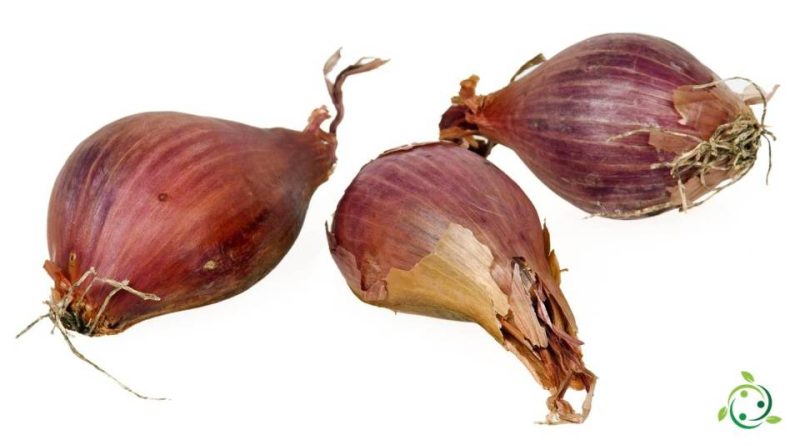Nutritional value of shallots
Nutritional value of shallots
The shallot (Allium ascalonicum L..) is a plant of the Amaryllidaceae family, similar to the onion, with which it shares many characteristics and similarities of use.
Characteristics –
The shallot, a name that designates both the plant and its bulb, is a plant about 20-30 cm tall, with cylindrical leaves.
Within this species there are several varieties that resemble onions, but unlike these, they have a composite (not single) bulb.
The inflorescence is, as in all species of the genus Allium, formed by several trimerous flowers.
It produces seeds that are small and black.
Nutritional card –
Shallots are a species that, from a nutritional point of view, have better characteristics than onions, both for the supply of vitamins and for the presence of minerals and antioxidants. Among the latter we mention vitamin A, selenium and manganese and compounds that are sources of allicin, a molecule that according to scientific studies can help reduce blood cholesterol levels.
From the point of view of its average composition, which can vary according to the type of cultivation and the soil and climatic conditions, 100 g of raw shallots provide about 72 calories and, moreover:
– 79.80 g of water;
– 2.50 g of protein;
– 0.10 g of lipids, including: 0.017 g of saturated fat, 0.014 g of monounsaturated fat and 0.039 g of polyunsaturated fat;
– 16.80 g of carbohydrates;
– 7.87 g of sugars;
– 3.2 g of fiber;
– 1190 IU of vitamin A;
– 8 mg of vitamin C;
– 0.345 mg of vitamin B6;
– 0.290 mg of pantothenic acid;
– 0.200 mg of niacin;
– 0.060 mg of thiamin;
– 0.020 mg of riboflavin;
– 34 µg of folate;
– 0.8 µg of vitamin K;
– 334 mg of potassium;
– 60 mg of phosphorus;
– 37 mg of calcium;
– 21 mg of magnesium;
– 12 mg of sodium;
– 1.20 mg of iron;
– 0.40 mg of zinc;
– 0.292 mg of manganese;
– 0.088 mg of copper;
– 1.2 µg of selenium;
– as well as various flavonoids.
Property –
Shallots, like many vegetables, are predominantly composed of water, to which are added fibers and oligo nutrients that are important for the proper functioning of our body:
among the various minerals present, it has been seen that the shallot is rich in sodium, potassium, calcium, phosphorus, selenium, silicon.
Selenium is an element that binds well with the sulfur of which the shallot is rich, and is present in many tissues of our body: it is important for growth, has an antioxidant action and is therefore attributed anti-aging properties.
The good silicon content would instead make shallots useful against osteoporosis and for strengthening nails and hair, given the relationship between the latter and calcium.
The supply of vitamin C is good (although it must be considered that to assimilate it at its best, shallots must be eaten raw, since cooking destroys it), as well as vitamin A, and group B vitamins.
It has been reported in scientific literature that shallots contain more flavonoids and phenols than any other member of the onion family.
Among the flavonoids, vegetable substances and antibiotic action, appear in particular the anthocyanins, substances that give the bulb a purplish color, very useful for the capillaries and for circulation in general, and quercetin, a molecule studied in the experimental oncological field and pressure regulator diastolic (the lowest).
The volatile components responsible for the aroma are instead retained by the sheath that surrounds the bulb and are activated when it is incised. The allinase enzyme, which is part of the defensive system that plants of the allium genus adopt to counter herbivores, is responsible for the catalysis of the chemical reactions involved in the production of volatile compounds which give these foods their characteristic aromas, odors and tear-producing properties. In particular among the latter, allyl sulphide is relevant, a volatile thioether which has a diuretic effect, as well as a disinfectant (vermifuge and bactericide).
For its potential disinfectant effect, in Indian tradition shallots mixed with sugar are used as a home remedy for sore throats.
Furthermore, allicin also seems to have anticancer, antidiabetic, antibacterial, antiviral and antifungal properties, promotes the reduction of pressure by making blood vessels less rigid and seems to inhibit platelet aggregation, thus reducing cardiovascular risk.
Finally, it is reported that there are no interactions between the consumption of shallots and the intake of drugs or other substances. If in doubt, it is always good to ask your doctor for advice.

